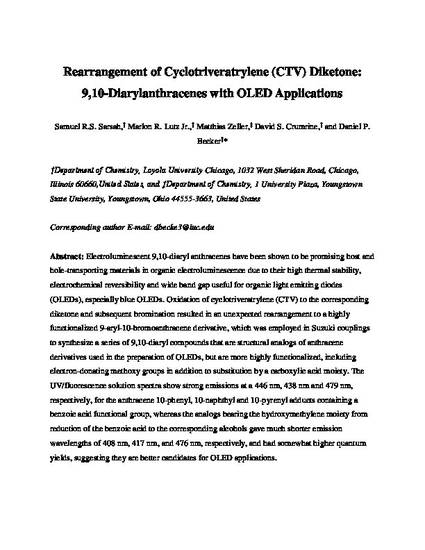
Electroluminescent 9,10-diaryl anthracenes have been shown to be promising host and hole-transporting materials in organic electroluminescence due to their high thermal stability, electrochemical reversibility, and wide band gap useful for organic light-emitting diodes (OLEDs), especially blue OLEDs. Oxidation of cyclotriveratrylene (CTV) to the corresponding diketone and subsequent bromination resulted in an unexpected rearrangement to a highly functionalized 9-aryl-10-bromoanthracene derivative, which was employed in Suzuki couplings to synthesize a series of 9,10-diaryl compounds that are structural analogues of anthracene derivatives used in the preparation of OLEDs but are more highly functionalized, including electron-donating methoxy groups in addition to substitution by a carboxylic acid moiety. The UV/fluorescence solution spectra show strong emissions at 446, 438, and 479 nm, respectively, for the anthracene 10-phenyl, 10-naphthyl, and 10-pyrenyl adducts containing a benzoic acid functional group, whereas the analogues bearing the hydroxymethylene moiety from reduction of the benzoic acid to the corresponding alcohols gave much shorter emission wavelengths of 408, 417, and 476 nm, respectively, and had somewhat higher quantum yields, suggesting they are better candidates for OLED applications.
© 2013 American Chemical Society
Available at: http://works.bepress.com/daniel_p_becker/6/

Author Posting © American Chemical Society, 2013. This is the author's version of the work. It is posted here by permission of American Chemical Society for personal use, not for redistribution. The definitive version was published in Journal of Organic Chemistry , Volume 78, Issue 5, March 1, 2013. http://dx.doi.org/10.1021/jo302139w